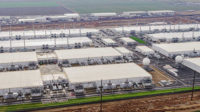“This new technology has the potential to alter the landscape of tomorrow’s power industry,” Abraham said. “It offers a preview of the day when more of our electricity will be generated by super-clean, high-efficiency power units sited near the consumer. Distributed generation could play a key role in strengthening the security and reliability of our power supply, and fuel cell-turbine hybrids could help make distributed power a reality.”
The system combines a Siemens Westinghouse solid oxide fuel cell with an Ingersoll Rand (formerly Northern Research and Engineering Corp.) microturbine. Solid oxide fuel cells are electrochemical devices that convert energy in a fuel cell into electricity, much like a battery. Microturbines are small, high-speed gas turbines. In the California unit, the two technologies combine to produce approximately 190 kW of electricity, enough to power about 200 homes.
Early test data show electrical efficiencies of approximately 53%, believed to be a record for the operation of any fuel cell system on natural gas. Improvements in the technology could ultimately raise efficiencies to 60% for smaller systems and 70% or higher for larger systems.
“In the power industry, efficiency gains of even a few percentage points can make a major economic difference over the life of a generating system,” said Richard Rosenblum, senior vice president for transmission and distribution at Southern California Edison, the system’s owner and operator. “We’ve combined two advanced technologies to work as a single, super-efficient unit. The microturbine is being driven by the hot pressurized exhaust produced by the fuel cells, which accounts for its high efficiency.” Because it operates on an electrochemical process, rather than combustion, the system emits virtually none of the air pollutants commonly released by conventional power plants. Its emissions of nitrogen oxide, which can contribute to urban smog, are nearly 50 times less than today’s average natural gas turbine.
“Siemens Westinghouse has long been committed to bringing clean, efficient power generation options to the mainstream energy market,” said Randy Zwirn, president and ceo. “Now, after 20 years of researching and developing the fuel cell technology and implementing projects like the Irvine system, we plan to deploy our first fuel cell products in the commercial market by fall 2003.”
The system has already passed the 1,000-hour proof-of-concept period during which it was gradually brought to its full performance level. The next step is to operate the system for an extended period of time to ensure system stability.
The Department of Energy (DOE) contract, which is managed by its National Energy Technology Laboratory, calls for a total test program of 3,000 hours. Funding partners in the $16 million project include the DOE, Edison International, Electric Power Research Institute, South Coast Air Quality Management District, and California Energy Commission.




